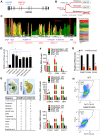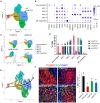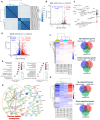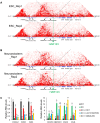An ancient enhancer rapidly evolving in the human lineage promotes neural development and cognitive flexibility
- PMID: 40802760
- PMCID: PMC12346275
- DOI: 10.1126/sciadv.adt0534
An ancient enhancer rapidly evolving in the human lineage promotes neural development and cognitive flexibility
Abstract
The genetic changes driving the evolution of humans since the human-chimpanzee split have been elusive. Here, we report a promising candidate in a chromosomal region linked with neurological defects-17p13.3. We show that this 442-nucleotide sequence-human-accelerated region (HAR) 123-is a conserved neural enhancer that promotes neural progenitor cell (NPC) formation. While present in all mammals, HAR123 has rapidly evolved since humans diverged from chimpanzees. The human and chimpanzee HAR123 orthologs exhibit subtle differences in their neural developmental effects, and the human HAR123 ortholog uniquely regulates many genes involved in neural differentiation. We identified direct targets of the HAR123 enhancer and showed that HIC1 acts downstream of HAR123 to promote human NPC formation. HAR123-knockout mice exhibit a defect in cognitive flexibility and a shift in neural-glia ratio in specific regions of the hippocampus. Our study has implications for neurodevelopmental disorders, which are often accompanied by altered neural-glia ratio and have been linked with HARs.
Figures





Similar articles
-
A human-specific enhancer fine-tunes radial glia potency and corticogenesis.Nature. 2025 Jul;643(8074):1321-1332. doi: 10.1038/s41586-025-09002-1. Epub 2025 May 14. Nature. 2025. PMID: 40369080
-
Resolving the three-dimensional interactome of human accelerated regions during human and chimpanzee neurodevelopment.Cell. 2025 Mar 20;188(6):1504-1523.e27. doi: 10.1016/j.cell.2025.01.007. Epub 2025 Jan 30. Cell. 2025. PMID: 39889695
-
Short-Term Memory Impairment.2024 Jun 8. In: StatPearls [Internet]. Treasure Island (FL): StatPearls Publishing; 2025 Jan–. 2024 Jun 8. In: StatPearls [Internet]. Treasure Island (FL): StatPearls Publishing; 2025 Jan–. PMID: 31424720 Free Books & Documents.
-
The Black Book of Psychotropic Dosing and Monitoring.Psychopharmacol Bull. 2024 Jul 8;54(3):8-59. Psychopharmacol Bull. 2024. PMID: 38993656 Free PMC article. Review.
-
Direct composite resin fillings versus amalgam fillings for permanent posterior teeth.Cochrane Database Syst Rev. 2021 Aug 13;8(8):CD005620. doi: 10.1002/14651858.CD005620.pub3. Cochrane Database Syst Rev. 2021. PMID: 34387873 Free PMC article.
References
-
- Pollard K. S., Salama S. R., Lambert N., Lambot M. A., Coppens S., Pedersen J. S., Katzman S., King B., Onodera C., Siepel A., Kern A. D., Dehay C., Igel H., Ares M. Jr., Vanderhaeghen P., Haussler D., An RNA gene expressed during cortical development evolved rapidly in humans. Nature 443, 167–172 (2006). - PubMed
-
- Prabhakar S., Noonan J. P., Paabo S., Rubin E. M., Accelerated evolution of conserved noncoding sequences in humans. Science 314, 786 (2006). - PubMed
-
- Girskis K. M., Stergachis A. B., DeGennaro E. M., Doan R. N., Qian X., Johnson M. B., Wang P. P., Sejourne G. M., Nagy M. A., Pollina E. A., Sousa A. M. M., Shin T., Kenny C. J., Scotellaro J. L., Debo B. M., Gonzalez D. M., Rento L. M., Yeh R. C., Song J. H. T., Beaudin M., Fan J., Kharchenko P. V., Sestan N., Greenberg M. E., Walsh C. A., Rewiring of human neurodevelopmental gene regulatory programs by human accelerated regions. Neuron 109, 3239–3251.e7 (2021). - PMC - PubMed
MeSH terms
LinkOut - more resources
Full Text Sources
Miscellaneous

